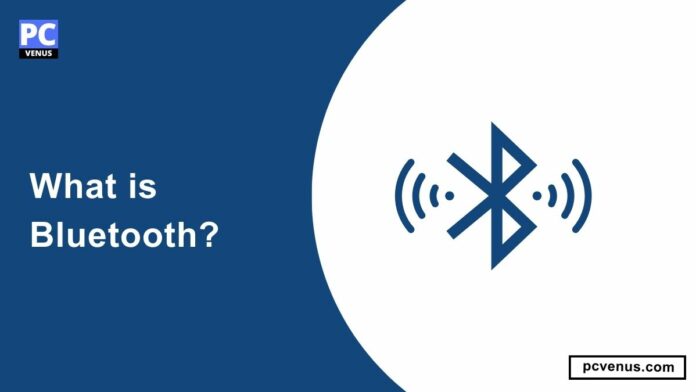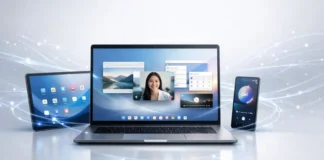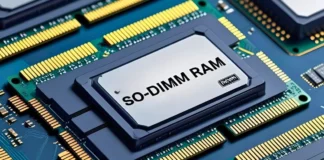Have you ever wondered how you can connect your phone to your car stereo or your laptop to your wireless headphones without using any cables and physical connections? The answer is Bluetooth, a wireless technology that exchanges data over short distances and enables the connection of electronic devices. Nowadays, many advanced technologies of Bluetooth have come, which are being built into new-age devices like smartwatches, smart TVs, home theatres, etc.
But how does Bluetooth work, and what are its advantages and disadvantages? How can you use it to improve your personal and professional life? And what are the best practices and tips for getting the most out of this technology? In this blog post, we’ll answer these questions and show you how Bluetooth can make your life easier and more enjoyable.
Table of Contents
History and Development

Bluetooth technology was originally developed by Ericsson, a Swedish telecommunications company, in the 1990s. It was intended to be a wireless replacement for RS-232 data cables commonly used to connect devices such as computers, printers, and modems.
The name “Bluetooth” is derived from the 10th-century king of Denmark, King Harald Bluetooth, who was known for his ability to unite different families and regions just as Bluetooth technology unites different devices.
Over the years, Bluetooth has undergone several advancements and iterations to improve its capabilities.
Bluetooth technology has evolved significantly over the years, introducing new features and capabilities that enhance wireless communication.
One of the major aspects of this evolution is the improvement in data transfer speed. Bluetooth 2.0 introduced Enhanced Data Rate (EDR), which increased the data transfer speed from 1 Mbps to 3 Mbps.
Bluetooth 3.0 introduced the High-Speed (HS) feature, allowing for faster data transfer rates of up to 24 Mbps by using an alternative radio technology, such as Wi-Fi.
The Bluetooth 4.0 version brought low-energy (LE) technology, which significantly reduced power consumption, making it ideal for devices like fitness trackers and smartwatches that need to operate for long periods of time.
Bluetooth 5.0, the latest major version, introduced further improvements in range, speed, and data capacity, enabling data transfer rates up to 50 Mbps, ranges up to 240 meters, and data packets up to 255 bytes.
These features allow Bluetooth devices to support more complex and demanding applications, such as streaming audio and video, the Internet of Things (IoT), and location services.
How Does Bluetooth Work?

Bluetooth works by using radio waves to establish a wireless connection between two or more devices.
1. Pairing: To establish a connection, the connected devices must go through the pairing process. During this process, one device becomes the “host” or “master,” while the other becomes the “client” or “slave.” The host device starts the pairing process and sends a signal to search for nearby Bluetooth devices. The “host” or “master” sends the data while the client receives the data.
2. Frequency Hopping: Bluetooth uses a technology called frequency hopping spread spectrum (FHSS) to avoid interference from other wireless devices. It jumps between different frequencies within the 2.4 GHz ISM (Industrial, Scientific, and Medical) band, switching channels rapidly to ensure a stable and reliable connection.
3. Data Transmission: Once the devices are paired, they establish a secure connection and are ready to transmit data. Bluetooth uses a protocol stack to handle various aspects of communications, including data formatting, error-checking, and encryption. First, the data is divided into packets and transmitted over the Bluetooth link.
4. Range and Profiles: The usual range of Bluetooth is up to 10 meters (33 feet), but with the advent of Bluetooth 5.0, its range can be increased to 100 meters (330 feet). At the same time, the range may vary depending on environmental factors such as obstacles and interference. Bluetooth also supports various profiles, which define a device’s specific capabilities and functions, such as audio streaming or file transfer.
5. Power Consumption: Bluetooth technology is designed to be energy-efficient to optimize battery life. It uses low-power modes and adaptive power control to minimize power consumption when devices are not actively transmitting data.
Key Features of Bluetooth

1. Wireless Connectivity: Bluetooth provides wireless connectivity between devices, eliminating the need for physical cables or wires.
2. Short-range communication: Bluetooth works at short range, usually up to 10 meters (33 feet); although Bluetooth 5.0 can extend this range to 100 meters (330 feet), it is still short.
3. Low Power Consumption: Earlier Bluetooths were not very energy efficient, but newer Bluetooth devices like Bluetooth v5.3 are designed to be energy efficient, allowing devices to run on less power and save battery life.
4. Universal Compatibility: Bluetooth is a standardized technology that provides compatibility between different devices from different manufacturers.
5. Secure Communication: Bluetooth uses encryption and authentication mechanisms to transmit data between devices, keeping the data secure and protected from interference.
6. Easy Pairing: Pairing Bluetooth devices is absolutely easy. Anyone can easily connect these with a few clicks or taps on their devices.
7. Multi-device Connections: Bluetooth can connect multiple devices simultaneously, enabling seamless communication between them.
8. Profile Support: Bluetooth supports various profiles that define specific functionalities, such as hands-free calling (HFP), file transfer (FTP), and audio streaming (A2DP).
9. Interference Avoidance:Bluetooth uses frequency hopping technologies to avoid interference from other nearby wireless devices.
10. Continuous Development: Bluetooth technology continues to evolve, with new versions and updates being released to improve performance, range, and functionality.
Advantages
1. Wireless Convenience: Bluetooth eliminates the need for cables and wires, providing a convenient way to connect and communicate between devices.
2. Easy to Use: Bluetooth devices can be easily paired with each other, often with a simple one-time setup process.
3. Low Power Consumption: Bluetooth technology is designed to be energy-efficient, which helps in preserving the battery life of connected devices.
4. Universal Compatibility: Bluetooth is a widely adopted standard, ensuring compatibility between different devices from various manufacturers.
5. Short-Range Communication: Bluetooth operates over short distances, reducing the risk of interference from other devices and ensuring a secure connection.
Disadvantages
1. Limited Range: Bluetooth has a limited range, typically up to 30 feet. This can be a limitation when trying to maintain a connection between devices that are far apart.
2. Data Transfer Speed: Bluetooth is not as fast as other wireless technologies like Wi-Fi or wired connections when it comes to transferring large files or streaming high-resolution content.
3. Interference: Bluetooth signals can be affected by other wireless devices and physical obstructions, which may cause a decrease in signal strength and quality.
4. Device Compatibility: While Bluetooth is generally compatible across devices, there can still be issues with compatibility between different versions of Bluetooth and different device implementations.
5. Security Concerns: Like any wireless technology, Bluetooth is susceptible to security risks such as unauthorized access or data interception. It is important to ensure proper security measures are in place when using Bluetooth.
You Might Also Like
Different Versions and Standards
Bluetooth technology has evolved over the years, leading to different versions and standards. Here are some of the main Bluetooth versions and standards:
Bluetooth 1.x: The initial version of Bluetooth that provided basic wireless connectivity for devices. It had limited data transfer speeds and was susceptible to interference.
Bluetooth 2.0: Introduced in 2004, Bluetooth 2.0 improved data transfer speeds and introduced Enhanced Data Rate (EDR) for faster and more efficient data transmission.
Bluetooth 3.0: It was released in 2009. This Bluetooth 3.0 introduced the High-Speed (HS) feature. This version allowed for faster data transfer rates by utilizing a Wi-Fi connection for bulk data transfers.
Bluetooth 4.0: Also known as Bluetooth Low Energy (BLE) or Bluetooth Smart, Bluetooth 4.0 was introduced in 2010. It focused on low power consumption and enabled the development of devices such as fitness trackers and smartwatches that could operate for extended periods on small batteries.
Bluetooth 4.x: Bluetooth 4.0 was further enhanced with subsequent updates, including Bluetooth 4.1, 4.2, and 4.3. These updates brought improvements in security, speed, and efficiency.
Bluetooth 5.0: Released in 2016, Bluetooth 5.0 introduced significant enhancements in range, speed, and data capacity. It increased the range of Bluetooth connections up to 100 meters (330 feet) and provided improved data transfer speeds.
Bluetooth 5.x: Similar to Bluetooth 4.x, Bluetooth 5.0 has also received updates, including Bluetooth 5.1 and 5.2. These updates introduced features like improved location tracking and enhanced audio quality.
Applications

Today, Bluetooth technology is widely adopted and used in various industries, including consumer electronics, automotive, healthcare, and smart home applications. It continues to evolve to meet the growing demands of wireless connectivity and data transfer.
1. Wireless Audio Streaming: Bluetooth allows for wireless audio streaming between devices. This enables users to connect their smartphones or tablets to Bluetooth speakers, headphones, or car audio systems, allowing for convenient and high-quality audio playback.
2. Hands-Free Calling: Bluetooth technology enables hands-free calling in vehicles. Users can connect their smartphones to their car’s Bluetooth system, allowing them to make and receive calls without having to hold their phones.
3. Wireless Data Transfer: Bluetooth can be used to transfer files, documents, photos, and other data between devices. This eliminates the need for physical cables and allows for seamless data transfer between smartphones, tablets, and computers.
4. IoT (Internet of Things) Connectivity: Bluetooth plays a crucial role in connecting smart home devices. It allows users to control and monitor devices such as smart thermostats, lighting systems, door locks, and security cameras from their smartphones or tablets.
5. Wearable Technology: Bluetooth is widely used in wearable devices such as smartwatches and fitness trackers. It enables these devices to connect to smartphones and other devices, allowing users to view notifications, track fitness data, and control various functions.
6. Gaming Controllers: Bluetooth technology is used in gaming controllers, allowing them to connect wirelessly to gaming consoles, PCs, or smartphones. This provides a more comfortable and flexible gaming experience.
7. Healthcare and Medical Devices: Bluetooth technology is utilized in medical devices such as glucose meters, blood pressure monitors, and heart rate monitors. It enables these devices to transmit data to smartphones or other devices for tracking and analysis.
8. Location-Based Services: Bluetooth beacons are used for location-based services in various settings, such as retail stores, museums, and airports. These beacons transmit signals that can be received by smartphones, providing personalized information, offers, and navigation assistance.
Challenges faced by Bluetooth technology
1. Interference: Bluetooth operates in the 2.4 GHz frequency range, which is shared with other wireless devices like Wi-Fi and microwaves. This can sometimes lead to interference and signal degradation.
2. Range: Bluetooth is designed for short-range communication, typically up to 100 meters (For Bluetooth 5.0 it is 240 meters). However, the actual range can vary depending on environmental factors and obstacles.
3. Data transfer speed: While Bluetooth has improved over the years, it still has limitations in terms of data transfer speed compared to other wireless technologies like Wi-Fi or wired connections.
4. Power consumption: Bluetooth devices consume power, and optimizing battery life for wireless devices is a challenge. However, advancements in low-energy Bluetooth protocols (such as Bluetooth Low Energy or Bluetooth Smart) have improved power efficiency.
You Might Also Like
- What is Firewall: Everything You Need to Know
- What is AI? Everything You Need to Know
- How Long Do Laptops Last: (Gaming, Business, MacBook)
Final Word
The advent of Bluetooth has revolutionized the way electronic devices connect and communicate. Bluetooth first came for some simple solutions, but now it has become a versatile wireless connection. There have been many improvements in Bluetooth technology, increasing speed, range, and efficiency. Although it has limited range and slower data transfer speeds compared to other wireless technologies, it still offers many advantages. It is very easy to connect, and it consumes very little energy. Its data transfer range is not large, which is why it is more secure; the possibility of external interference has been reduced.
Nowadays, it is used in a wide range of applications such as wireless audio streaming, hands-free calling, file sharing, IoT connectivity, wearable technology, gaming, healthcare, and location-based services.
With the continued development of Bluetooth technology and the introduction of new standards such as Bluetooth Low Energy and Bluetooth Mesh, the future promises even greater advancements in wireless connectivity and communications. As Bluetooth advances in the world of technology, it will play an integral role in shaping the way we interact with and use electronic devices in our personal and professional lives.
FAQs
Is Bluetooth only used for connecting audio devices?
No, Bluetooth is versatile and used for various applications. While wireless audio is common, Bluetooth also connects peripheral devices, facilitates IoT communication, and enables file sharing.
How does Bluetooth Low Energy (BLE) differ from previous Bluetooth versions?
Bluetooth Low Energy (BLE), introduced in Bluetooth 4.0, is designed for energy-efficient communication, making it suitable for devices with limited power, like fitness trackers and smartwatches.
Can Bluetooth devices connect over long distances?
Bluetooth typically operates over short distances, up to 10 meters or 33 feet. However, advancements in Bluetooth 5.0 and beyond have extended the range for specific applications.
What is Bluetooth Mesh, and how does it differ from traditional Bluetooth?
Bluetooth Mesh is an extension of traditional Bluetooth that enables devices to create a mesh network. This enhances coverage and reliability, making it suitable for larger-scale IoT applications.
Can Bluetooth interfere with other wireless devices?
Bluetooth may experience interference from other wireless devices in the same frequency range. Advanced techniques, such as frequency hopping, help mitigate interference and ensure reliable communication.




